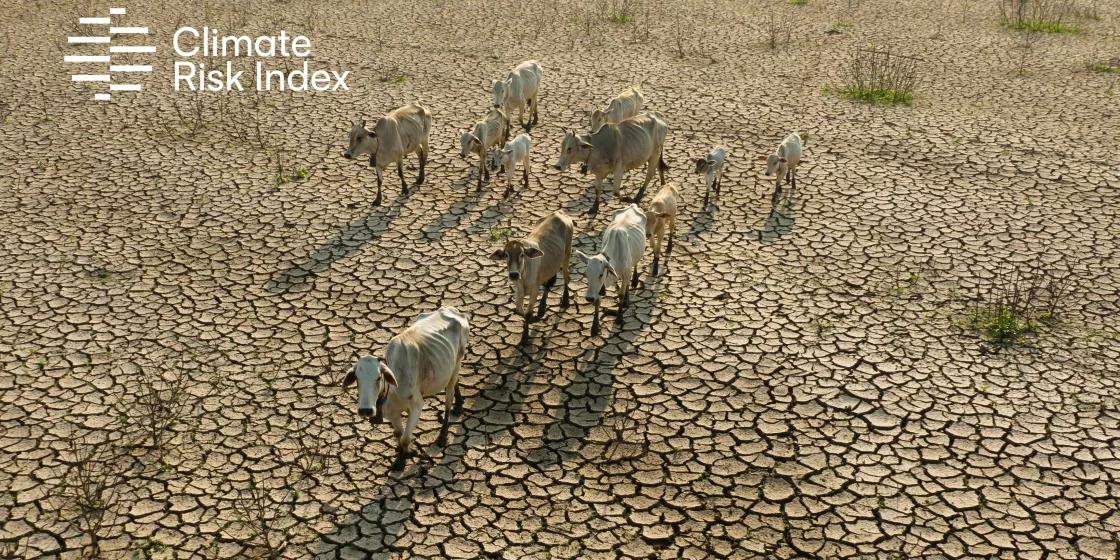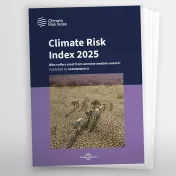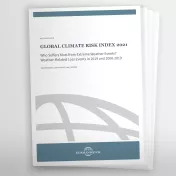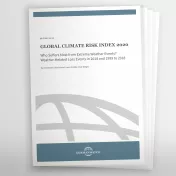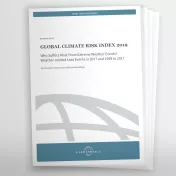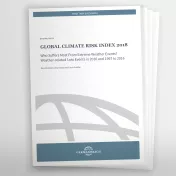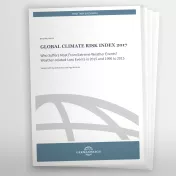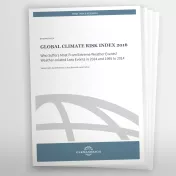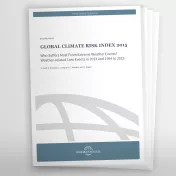The Climate Risk Index (CRI), published since 2006, is one of the longest running annual climate impact-related indices. The CRI analyses climate-related extreme weather events’ degree of effect on countries. In doing so, it measures the consequences of realised risks on countries.
This backward-looking index ranks countries by their economic and human impacts (fatalities as well as affected, injured, and homeless) with the most affected country ranked highest.
The CRI visualises such events’ degree of effect at two years before the index’s publication and over the preceding 30 years. The index contextualises international climate policy debates and processes with a view to the climate risk countries are facing. It simplifies the aggregation and understanding of climate-related extreme weather events’ impacts across different regions and time periods. The most strongly affected countries rank highest and should view the CRI results as a warning sign that they are at risk of frequent events or rare and unusual extreme events.
CRI 2025 ranking and results highlights
Scorching heat, heavy rainfalls, raging wildfires, deadly floods, and devastating storms: The manifestations of extreme weather events have become too common in a new reality worldwide. The Climate Risk Index 2025 relaunch sheds light on inaction’s growing cost. It reveals the mounting human and economic toll.
From 1993 to 2022, more than 765,000 lives were lost and direct economic losses of nearly USD 4.2 trillion (inflation-adjusted) were recorded, driven by more than 9,400 extreme weather events. The frequency and intensity of climate-related disasters continue to rise, and these figures underscore the urgent need for climate action.
For a comprehensive overview of the results, see the full report here.
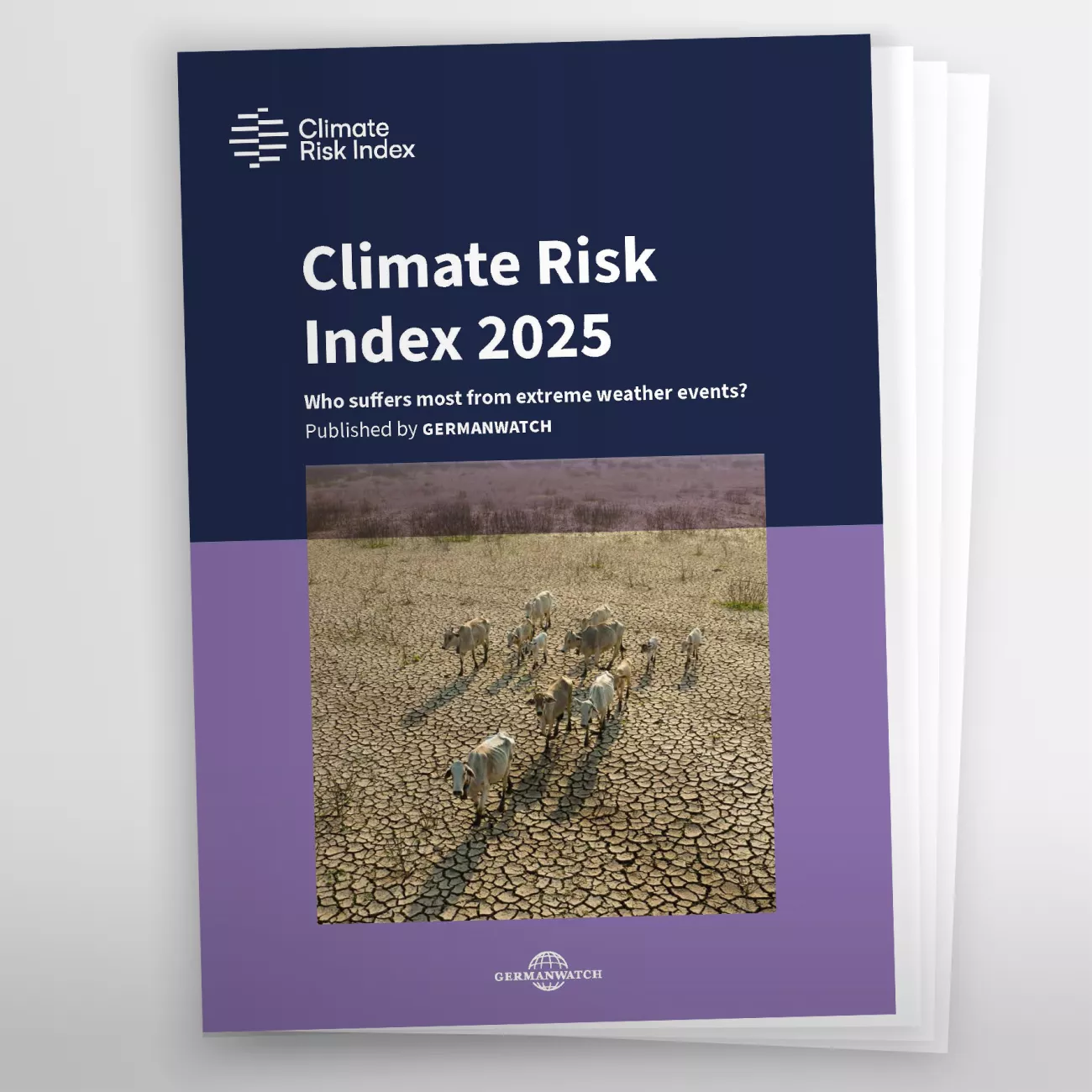
For a brief overview of the results, see the summary of the report here.
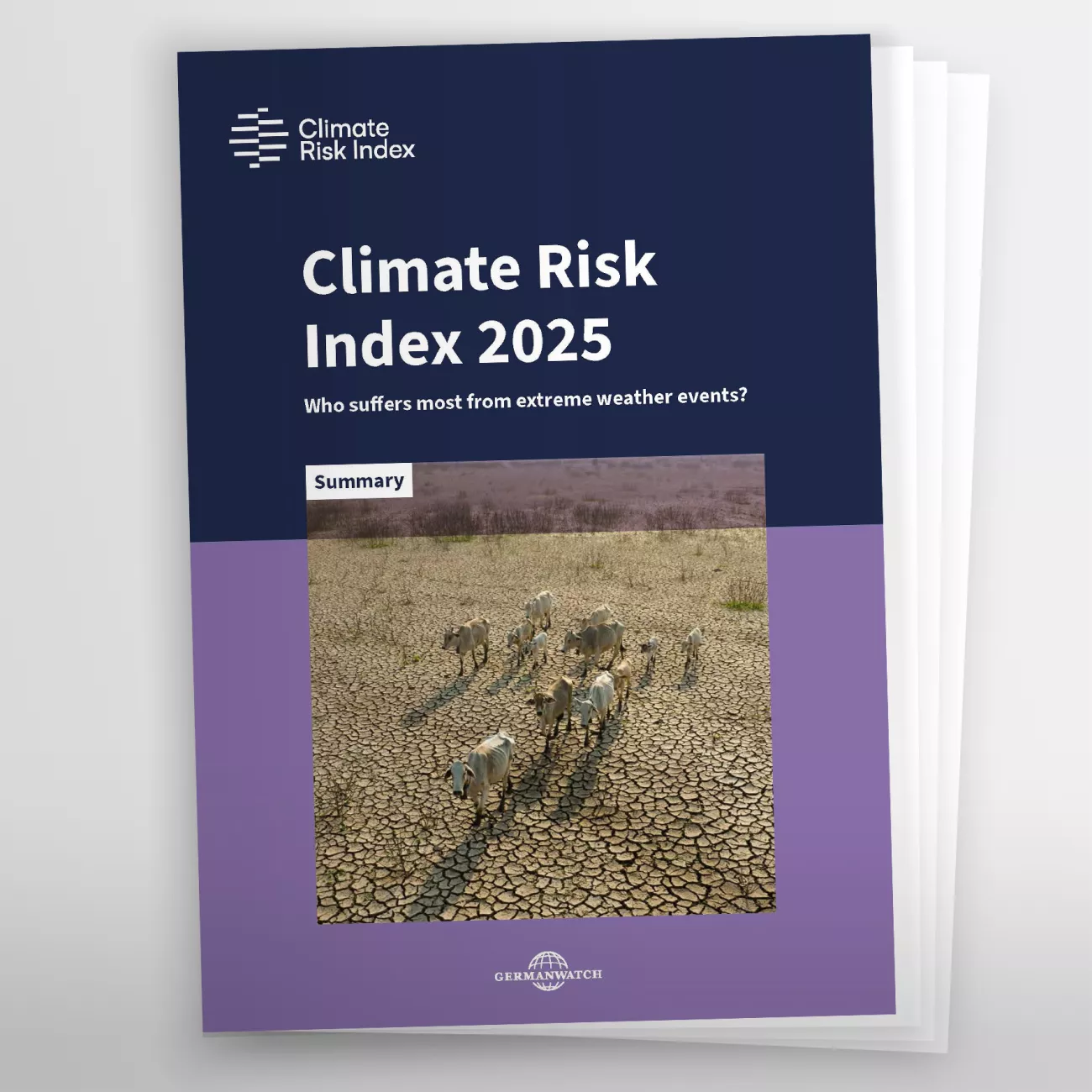
Methodology
The CRI methodology involves analysing extreme weather events’ impacts via three hazard categories: hydrological, meteorological, and climatological. The index visualises these events’ impact on countries both two years prior to publication and over the preceding 30-year period. It draws on data from the EM-DAT international disaster database, World Bank, and International Monetary Fund (IMF). The index considers absolute and relative impacts, using six key indicators: economic loss, fatalities, and affected people – each in absolute and relative terms.
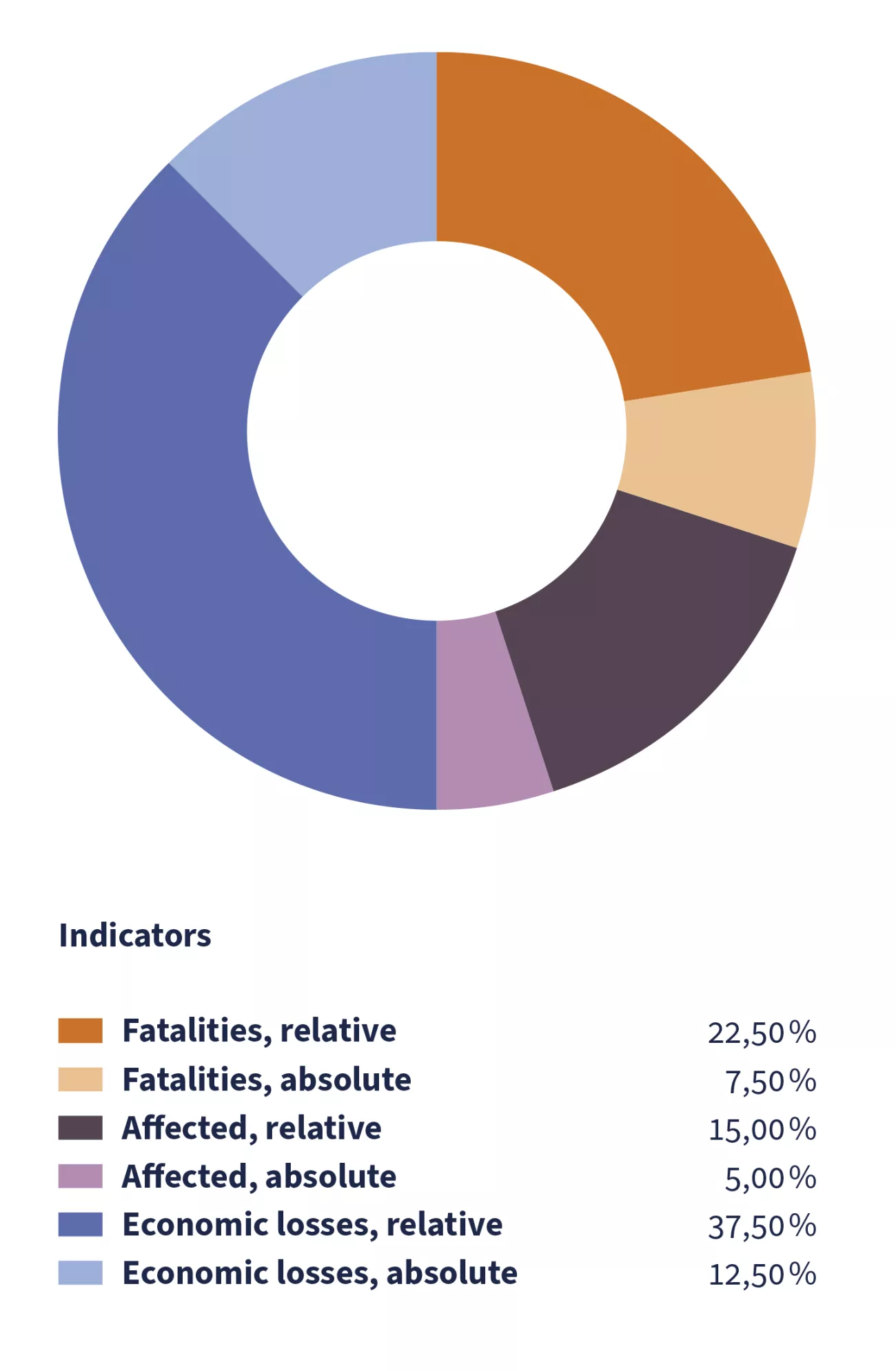
Explore an interactive map of the full ranking and results here. Click on a country to see how extreme weather events affect it, in terms of the economic and human impacts.
- Most affected countries in 1993–2022. This map shows the countries extreme weather events most affected from 1993 to 2022, based on the impacts on people and on economic loss.
- Map text: Most affected countries in 2022. This map highlights the countries extreme weather events most affected in 2022, based on the impacts on people and on economic loss.
CRI 2025 key messages
- The Climate Risk Index (CRI) ranking indicates that, in 1993–2022, Dominica, China, and Honduras were the countries most affected by extreme weather events’ impacts.
- The ranking shows Pakistan, Belize, and Italy as the most affected by extreme weather events’ impacts in 2022.
- From 1993 to 2022, 765,000+ people died worldwide and direct losses of nearly USD 4.2 trillion (inflation-adjusted) directly resulted from 9,400+ extreme weather events.
- Floods, storms, heat waves, and drought were the most prominent impacts from short- and long-term perspectives. From 1993 to 2022, storms (35%), heat waves (30%), and floods (27%) caused the most fatalities. Floods were responsible for over half of the people affected. Storms caused, by far, the most significant economic losses (56% or USD 2.33 trillion inflation-adjusted), followed by floods (32% or USD 1.33 trillion).
- The most affected countries in the long-term index for 1993–2022 can be divided into two groups: (1) Countries most affected by highly unusual extreme events (e.g. Dominica, Honduras, Myanmar, Vanuatu) and (2) countries affected by recurring extreme events (e.g. China, India, the Philippines). Climate science clearly shows that climate change increases the risk for both categories and contributes to transforming uncommonly extreme events into continual threats, creating a ‘new normal.’
- The CRI shows that all countries are affected. Seven of the 10 most affected countries in 2022 belonged to the high-income country group1. This clearly indicates that, while the coping capacities of high-income countries significantly exceed those of lower-income countries, higher-income countries should also increase their climate risk management. Over the long term, the ranking shows that extreme weather events’ impacts particularly affect Global South countries. With five countries, the lower middle-income group is the largest country group among the 10 most affected countries, including three Small Island Developing States/Least Developed Countries, where coping capacities are significantly lower.
- The CRI ranking is based on the best publicly available historical data set on the extreme weather events’ impacts. Extreme weather events and their impacts are often underreported in Global South countries because of data quality and coverage challenges and data gaps. As a result, this ranking may less accurately capture these impacts and, therefore, how Global South countries are affected.
- Human-induced climate change affects the frequency and intensity of extreme weather events and leads to widespread adverse climate impacts. The latest climate science and significantly improved attribution science suggest climate change’s influence on extreme weather events is ‘on the same level of scientific confidence as the statement that human influence has warmed the climate.2
- COP29 failed to deliver an ambitious New Collective Quantified Goal (NCQG) on Climate Finance. Considering the identified needs, and the great urgency of the climate challenges that developing countries face, the USD 300 billion annually by 2035 can only be seen as the bare minimum response to the escalating climate crisis. The NCQG also failed to include measures to address loss and damage. This gap must be filled as soon as possible. This situation is even more worrying given the extensive gaps in adaptation finance compared with the needs and commitments (even if progress was made). Substantially increased support by high-emitting countries and other polluters is needed for the most vulnerable in addressing climate impacts.
- The CRI shows that a lack of ambition and action in mitigation leads to being strongly affected, even in high-income countries. It is in the interest of high-income and highly emitting countries to ramp up mitigation action, including higher climate targets and such action’s implementation, with new nationally determined contributions (NDCs), to stay below (or as close as possible to) 1.5°C warming and keep impacts at a manageable scale.
- Footnote (click to open)
-
1: For a definition of income groups, see World Bank 2024
2: Otto,F. 2023: Attribution of Extreme Events to Climate Change. Annu. Rev. Environ. Resour. 2023. 48:813–28 https://doi.org/10.1146/annurev-environ-112621-083538
FAQ: Understanding the CRI
The CRI is a tool that assesses extreme weather events’ impacts on countries and regions. It ranks countries based on these events’ economic and human impacts two years before publication and over the preceding 30 years. In this way, it measures realised risks’ consequences for countries.
The CRI has not been available in recent years because extreme weather event data from the previous data provider was discontinued. The index now uses the EM-DAT international disaster database as its primary data source.
In addition to the new database for extreme weather events, a new normalisation technique is applied together with an updated weighting of the indicators.
The CRI measures actual human and economic impacts from extreme weather events. It is a retrospective analysis of realised climate risks.
The CRI is updated annually, incorporating the latest data on extreme weather events from two years prior. CRI 2025 is an exception, considering the latest available data from 2022.
CRI 2025 covers 171 countries. Some countries are not reflected because of data availability.
The index examines hydrological, meteorological, and climatological events. Fatalities and economic loss from seven hazard types are included in these categories. A composite score is then generated for ranking countries.
The CRI relies on data from EM-DAT, the World Bank, and the IMF.
This occurs because small countries often have higher relative fatalities and economic losses, owing to their smaller populations and GDP. Thus, extreme events’ impacts are more significant in relative terms, even if absolute losses are smaller.
No, it cannot. The CRI is a retrospective analysis of past extreme weather-related impacts. However, it serves as a warning for countries likely to face similar events in the future.
You can access the full list of country rankings in the full report.
The CRI relies on the best publicly available databases for generating the results. However, data gaps arise due to variations in data quality and coverage, especially regarding the Global South. Under-representation in research, uneven distribution of meteorological stations, and differing data collection techniques across countries are among the key challenges.
Currently, the CRI is applied only at the national level.
No, the CRI focuses on sudden-onset extreme weather events, such as floods, storms, and heat waves. Slow-onset changes, such as sea-level rise, are not included.
Yes, the CRI team welcomes feedback and suggestions for methodological improvements. Please submit your ideas via this email: cri@germanwatch.org.
The CRI database will generally be available for research and academic purposes. Please email your request for access to cri@germanwatch.org and please provide a clear description of how you plan to use the data. Data availability will be assessed on a case-by-case basis, with preference for academic and public policy research.
Please cite the CRI 2025 edition as follows:
Adil, L.; Eckstein, D.; Kuenzel, V.; Schaefer, L.: Climate Risk Index 2025 – Who suffers most from extreme weather events? Available at: http://www.germanwatch.org/en/93013
Disclaimer
The content and works on these pages created by the operators of these pages are subject to German copyright law. The reproduction, processing, dissemination and all kinds of use outside the limits of copyright require the written consent of each author or creator. Downloads or copies of this publication are for private, non-commercial use only. If the content on this site was not created by the operator, the rights in copyright of third parties were respected. In particular, content of third parties is marked as such. Nevertheless, should you notice a breach of copyright, you are requested to let us know. If we become aware of a breach of the law, we will remove this content immediately.
